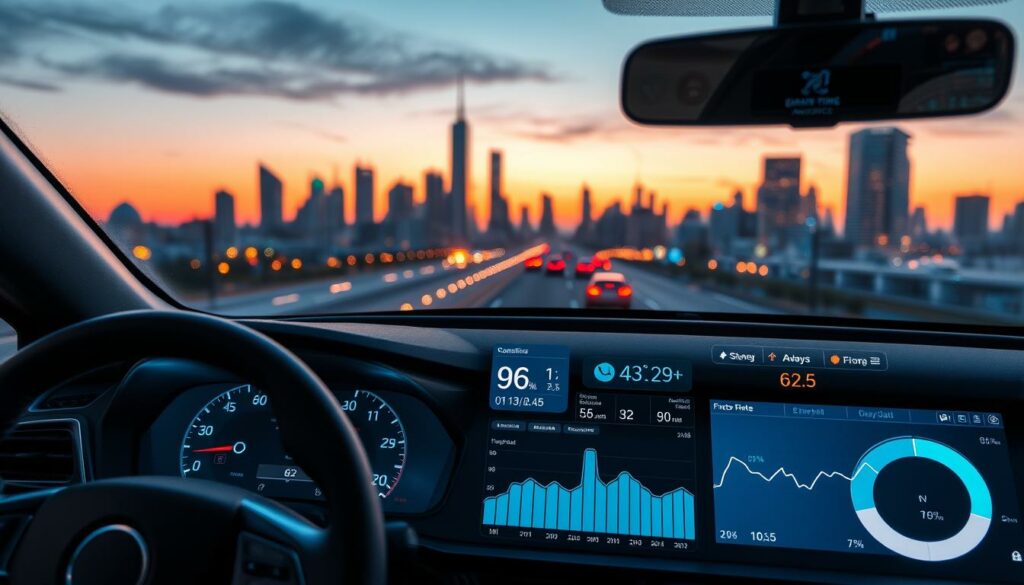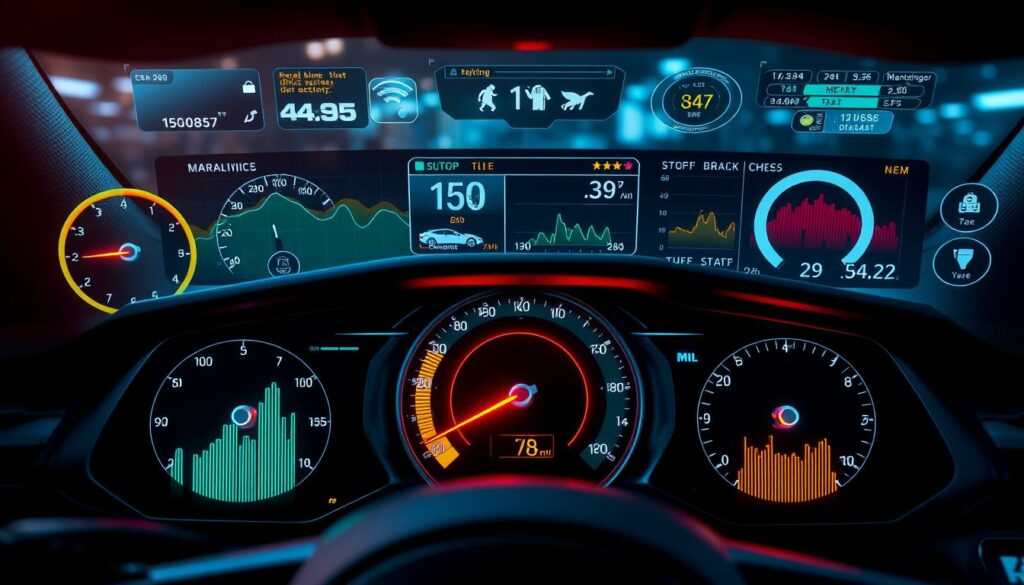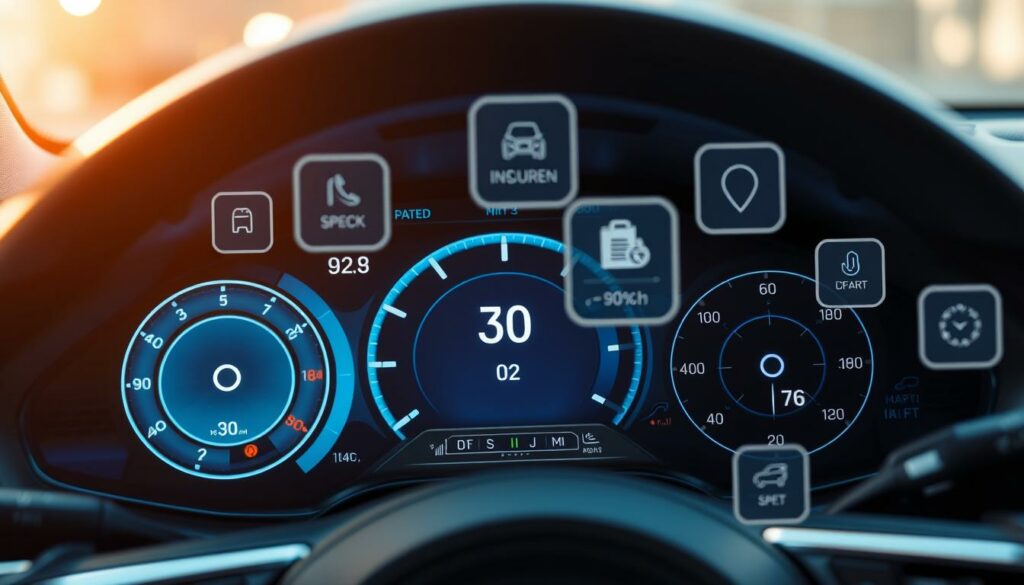A new way of insuring cars has come along – usage-based car insurance. It links your insurance cost to how much you drive and your driving habits. This could mean you pay less if you drive less and drive safely.
This model uses pay-per-mile insurance and telematics to watch your driving. It looks at things like how far you drive, how fast you go, and when you drive. This way, your insurance can be more suited to you, saving you money if you’re a careful driver.

As this new insurance type grows, we need to think about its good and bad sides. It affects the environment and raises privacy worries because of the data it collects. This article will dive into the different sides of usage-based car insurance. It aims to help you understand it better so you can choose the right insurance for you.
Also Read: Comprehensive vs. Collision Car Insurance: Key Facts
What is Usage-Based Car Insurance?
Usage-based car insurance, also known as *pay-per-mile insurance* or *telematics-based insurance*, is a new way to cover cars. It uses in-car tech to track how much you drive and how you drive. This lets insurers set your premium based on your actual driving, not just who you are.
Pay-per-Mile Insurance
The main idea behind this insurance is the pay-per-mile concept. You pay a base rate plus a fee for each mile you drive. This encourages you to drive less, which can help you save money on insurance.
This approach tries to make insurance fairer and more personal. It fits the different ways people drive today.
Telematics and Driving Behavior Monitoring
The heart of usage-based insurance is the use of *telematics*. This tech tracks your driving habits, like how fast you go and how well you brake. Insurers use this info to figure out how risky you are as a driver.
They then offer you a premium that matches your driving style. If you drive safely, you might pay less.

This method of car insurance is all about being clear and personal. It lets drivers play a big part in their insurance costs. By driving better, you could save money.
Personalized Premiums: The Advantages
One of the main perks of usage-based car insurance is getting premiums tailored just for you. If you drive less or drive safely, you can save money. This includes low-mileage discounts and rewards for being a careful driver.
Low-Mileage Discounts
Driving less means paying less with usage-based insurance. If you don’t drive much, like for work or occasional trips, you can get big discounts. This is because you’re seen as a lower risk by insurance companies, leading to big savings.
Rewards for Safe Driving
Usage-based insurance also gives you rewards for safe driving. It tracks how you drive, like how smoothly you accelerate and brake. If you drive well, you get discounts or other perks. This makes you more careful and helps keep everyone safer on the road.

Telematics and data help you control your insurance costs and get rewards for safe driving. This approach is good for you and makes the roads safer for everyone.
Also Read: Car Insurance Basics: What You Need to Know
The Pros and Cons of Usage-Based Car Insurance
Usage-based car insurance has its ups and downs. It can offer personalized rates and rewards for safe driving. But, it also raises privacy concerns and might charge more for risky drivers.
One big plus is that you pay based on how you drive, not just how far you go. If you drive less or safer, you could save money. Some insurers even give discounts for driving green, which is good for the planet.
But, the need to track your driving can make some people uneasy. They might worry about their habits being watched, even if it means cheaper insurance. Also, those who drive riskier might end up paying more, which isn’t fair.
In the end, deciding on usage-based car insurance is a big choice. The chance to save money and drive safer is tempting. Yet, the privacy issues and possible higher costs for some might not be worth it for everyone. It’s key to think about these points before choosing.
Environmental Benefits of Usage-Based Insurance
Usage-based car insurance, also known as pay-per-mile or telematics-based insurance, has a big impact on the environment. It encourages drivers to drive less and drive more eco-friendly. This can lead to a big reduction in carbon footprint.
As drivers become more aware of their driving’s environmental effects, they might choose to drive more sustainably. This choice helps the planet.
Reduced Carbon Footprint
One key environmental benefit of usage-based insurance is a smaller carbon footprint. Drivers pay based on how much they drive. This makes them want to drive less and choose greener ways to get around.
They might use public transit, carpool, or even bike. This change can really cut down on greenhouse gas emissions. It makes the environment healthier.
Incentives for Eco-Friendly Driving
Usage-based insurance also gives incentives for eco-friendly driving. Drivers who drive safely, efficiently, and green get lower premiums or other perks. This motivates them to drive in ways that are better for the planet.
They might drive at the right speed, avoid sudden stops, and plan their route. By linking money savings to green driving, this insurance helps make transportation greener.
Privacy Concerns and Data Collection
Usage-based car insurance raises big privacy and data collection issues. Drivers worry about sharing their driving habits and personal info. They question how safe and private their data is.
Telematics technology in usage-based insurance collects a lot of data. This includes speed, braking, and how much you drive. While it helps offer better rates, it also makes people uneasy about their privacy.
Insurers need to find a middle ground. They must use data to offer good coverage while respecting customers’ privacy. Clear policies, strong data protection, and open talks about data use can help. This builds trust between insurers and their customers.
High-Risk Driver Surcharges
Usage-based car insurance can offer discounts for safe drivers. But, it can also charge more for high-risk drivers. Insurers use data from in-vehicle tech to watch driving habits. They then add surcharges for risky behaviors.
Monitoring Driving Habits
Telematics systems in these policies track driving aspects like speeding and sudden braking. Insurers use this data to spot risky driving. They then adjust premiums to reflect the risk, making high-risk drivers pay more.
This method encourages safer driving and holds drivers accountable. By monitoring habits closely, insurers can price policies better. This rewards safe drivers and discourages reckless ones.
FAQ
What is usage-based car insurance?
Usage-based car insurance is a new way to insure cars. It uses technology in your car to track how you drive and how far you go. This lets insurers set your premium based on your actual driving, not just who you are.
How do personalized premiums work in usage-based car insurance?
The big plus of usage-based insurance is that you can get a premium that fits you. If you drive less or drive safely, you might pay less for insurance. You could get discounts for driving fewer miles or for being a careful driver.
What are the pros and cons of usage-based car insurance?
There are good points and bad points to usage-based insurance. The good stuff includes premiums that match your driving, discounts for not driving much, and rewards for being careful. But, there are also privacy worries and the chance of paying more if you’re seen as a higher risk.
How does usage-based car insurance benefit the environment?
This type of insurance can help the planet. It encourages people to drive less and drive more carefully. This means less pollution and maybe even money back for those who choose to drive green.
What are the privacy concerns with usage-based car insurance?
A big worry with this insurance is privacy. It collects a lot of data on how you drive and where you go. People might not want to share this info, which raises questions about keeping it safe and private.
How do insurers monitor driving habits in usage-based car insurance?
Insurers can use the data from your car to see how you drive. They might give discounts to safe drivers but charge more to those who take risks. This is based on what your car’s technology shows about your driving habits.

